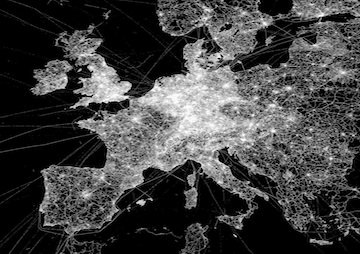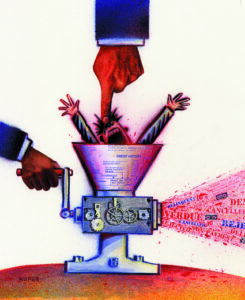The Collapse of Europe?
The European project is teetering on the edge of failure. Growth is anemic at best and socio-economic inequality is on the rise. The countries of Eastern and Central Europe, even relatively successful Poland, have failed to bridge the income gap with the richer half of the continent. And the highly indebted periphery is in revolt. stevefaeembra (CC BY-SA 2.0)
stevefaeembra (CC BY-SA 2.0)
By John Feffer, TomDispatchThis piece first appeared at TomDispatch. Read Tom Engelhardt’s introduction here.
Europe won the Cold War.
Not long after the Berlin Wall fell a quarter of a century ago, the Soviet Union collapsed, the United States squandered its peace dividend in an attempt to maintain global dominance, and Europe quietly became more prosperous, more integrated, and more of a player in international affairs. Between 1989 and 2014, the European Union (EU) practically doubled its membership and catapulted into third place in population behind China and India. It currently boasts the world’s largest economy and also heads the list of global trading powers. In 2012, the EU won the Nobel Peace Prize for transforming Europe “from a continent of war to a continent of peace.”
In the competition for “world’s true superpower,” China loses points for still having so many impoverished peasants in its rural hinterlands and a corrupt, illiberal bureaucracy in its cities; the United States, for its crumbling infrastructure and a hypertrophied military-industrial complex that threatens to bankrupt the economy. As the only equitably prosperous, politically sound, and rule-of-law-respecting superpower, Europe comes out on top, even if — or perhaps because — it doesn’t have the military muscle to play global policeman.
And yet, for all this success, the European project is currently teetering on the edge of failure. Growth is anemic at best and socio-economic inequality is on the rise. The countries of Eastern and Central Europe, even relatively successful Poland, have failed to bridge the income gap with the richer half of the continent. And the highly indebted periphery is in revolt.
Politically, the center may not hold and things seem to be falling apart. From the left, parties like Syriza in Greece are challenging the EU’s prescriptions of austerity. From the right, Euroskeptic parties are taking aim at the entire quasi-federal model. Racism and xenophobia are gaining ever more adherents, even in previously placid regions like Scandinavia.
Perhaps the primary social challenge facing Europe at the moment, however, is the surging popularity of Islamophobia, the latest “socialism of fools.” From the killings at the Munich Olympics in 1972 to the recent attacks at Charlie Hebdo and a kosher supermarket in Paris, wars in the Middle East have long inspired proxy battles in Europe. Today, however, the continent finds itself ever more divided between a handful of would-be combatants who claim the mantle of true Islam and an ever-growing contingent who believe Islam — all of Islam — has no place in Europe.
The fracturing European Union of 2015 is not the Europe that political scientist Frances Fukuyama imagined when, in 1989, he so famously predicted “the end of history,” as well as the ultimate triumph of liberal democracy and the bureaucracy in Brussels, the EU’s headquarters, that now oversees continental affairs. Nor is it the Europe that British Prime Minister Margaret Thatcher imagined when, in the 1980s, she spoke of the global triumph of TINA (“there is no alternative”) and of her brand of market liberalism. Instead, today’s Europe increasingly harkens back to the period between the two world wars when politicians of the far right and left polarized public debate, economies went into a financial tailspin, anti-Semitism surged out of the sewer, and storm clouds gathered on the horizon.
Another continent-wide war may not be in the offing, but Europe does face the potential for regime collapse: that is, the end of the Eurozone and the unraveling of regional integration. Its possible dystopian future can be glimpsed in what has happened in its eastern borderlands. There, federal structures binding together culturally diverse people have had a lousy track record over the last quarter-century. After all, the Soviet Union imploded in 1991; Czechoslovakia divorced in 1993; and Yugoslavia was torn asunder in a series of wars later in the 1990s.
If its economic, political, and social structures succumb to fractiousness, the European Union could well follow the Soviet Union and Yugoslavia into the waste bin of failed federalisms. Europe as a continent will remain, its nation-states will continue to enjoy varying degrees of prosperity, but Europe as an idea will be over. Worse yet, if, in the end, the EU snatches defeat from the jaws of its Cold War victory, it will have no one to blame but itself.
The Rise and Fall of TINA
The Cold War was an era of alternatives. The United States offered its version of freewheeling capitalism, while the Soviet Union peddled its brand of centralized planning. In the middle, continental Europe offered the compromise of a social market: capitalism with a touch of planning and a deepening concern for the welfare of all members of society.
Cooperation, not competition, was the byword of the European alternative. Americans could have their dog-eat-dog, frontier capitalism. Europeans would instead stress greater coordination between labor and management, and the European Community (the precursor to the EU) would put genuine effort into bringing its new members up to the economic and political level of its core countries.
Then, at a point in the 1980s when the Soviet model had ceased to exert any influence at all globally, along came TINA.
At the time, British Prime Minister Margaret Thatcher and American President Ronald Reagan were ramping up their campaigns to shrink government, while what later became known as globalization — knocking down trade walls and opening up new opportunities for the financial sector — began to be felt everywhere. Thatcher summed up this brave new world with her TINA acronym: the planet no longer had any alternative to globalized market democracy.
Not surprisingly, then, in the post-Cold War era, European integration shifted its focus toward removing barriers to the flow of capital. As a result, the expansion of Europe no longer came with an implied guarantee of eventual equality. The deals that Ireland (1973) and Portugal (1986) had received on accession were now, like the post-World War II Marshall Plan, artifacts of another era. The sheer number of potential new members knocking on Europe’s door put a strain on the EU’s coffers, particularly since the economic performance of countries like Romania and Bulgaria was so far below the European average. But even if the EU had been overflowing with funds, it might not have mattered, since the new “neoliberal” spirit of capitalism now animated its headquarters in Brussels where the order of the day had become: cut government, unleash the market.
At the heart of Europe, as well as of this new orthodoxy, lies Germany, the exemplar of continental fiscal rectitude. Yet in the 1990s, that newly reunified nation engaged in enormous deficit spending, even if packaged under a different name, to bring the former East Germany up to the level of the rest of the country. It did not, however, care to apply this “reunification exception” to other former members of the Soviet bloc. Acting as the effective central bank for the European Union, Germany instead demanded balanced budgets and austerity from all newcomers (and some old timers as well) as the only effective answer to debt and fears of a future depression.
The rest of the old Warsaw Pact has had access to some EU funds for infrastructure development, but nothing on the order of the East German deal. As such, they remain in a kind of economic halfway house. The standard of living in Hungary, 25 years after the fall of Communism, remains approximately half that of neighboring Austria. Similarly, it took Romania 14 years just to regain the gross national product (GDP) it had in 1989 and it remains stuck at the bottom of the European Union. People who visit only the capital cities of Eastern and Central Europe come away with a distorted view of the economic situation there, since Warsaw and Bratislava are wealthier than Vienna, and Budapest nearly on a par with it, even though Poland, Slovakia, and Hungary all remain economically far behind Austria.
What those countries experienced after 1989 — one course of “shock therapy” after another — became the medicine of choice for all EU members at risk of default following the financial crisis of 2007 and then the sovereign debt crisis of 2009. Forget deficit spending to enable countries to grow their way out of economic crisis. Forget debt renegotiation. The unemployment rate in Greece and Spain now hovers around 25%, with youth unemployment over 50%, and all the EU members subjected to heavy doses of austerity have witnessed a steep rise in the number of people living below the poverty line. The recent European Central Bank announcement of “quantitative easing” — a monetary sleight-of-hand to pump money into the Eurozone — is too little, too late.
The major principle of European integration has been reversed. Instead of Eastern and Central Europe catching up to the rest of the EU, pockets of the “west” have begun to fall behind the “east.” The GDP per capita of Greece, for example, has slipped below that of Slovenia and, when measured in terms of purchasing power, even Slovakia, both former Communist countries.
The Axis of Illiberalism
Europeans are beginning to realize that Margaret Thatcher was wrong and there are alternatives — to liberalism and European integration. The most notorious example of this new illiberalism is Hungary.
On July 26, 2014, in a speech to his party faithful, Prime Minister Viktor Orban confided that he intended a thorough reorganization of the country. The reform model Orban had in mind, however, had nothing to do with the United States, Britain, or France. Rather, he aspired to create what he bluntly called an “illiberal state” in the very heart of Europe, one strong on Christian values and light on the libertine ways of the West. More precisely, what he wanted was to turn Hungary into a mini-Russia or mini-China.
“Societies founded upon the principle of the liberal way,” Orban intoned, “will not be able to sustain their world-competitiveness in the following years, and more likely they will suffer a setback, unless they will be able to substantially reform themselves.” He was also eager to reorient to the east, relying ever less on Brussels and ever more on potentially lucrative markets in and investments from Russia, China, and the Middle East.
That July speech represented a truly Oedipal moment, for Orban was eager to drive a stake right through the heart of the ideology that had fathered him. As a young man more than 25 years earlier, he had led the Alliance of Young Democrats — Fidesz — one of the region’s most promising liberal parties. In the intervening years, sensing political opportunity elsewhere on the political spectrum, he had guided Fidesz out of the Liberal International and into the European People’s Party, alongside German Chancellor Angela Merkel’s Christian Democrats.
Now, however, he was on the move again and his new role model wasn’t Merkel, but Russian President Vladimir Putin and his iron-fisted style of politics. Given the disappointing performance of liberal economic reforms and the stinginess of the EU, it was hardly surprising that Orban had decided to hedge his bets by looking east.
The European Union has responded by harshly criticizing Orban’s government for pushing through a raft of constitutional changes that restrict the media and compromise the independence of the judiciary. Racism and xenophobia are on the uptick in Hungary, particularly anti-Roma sentiment and anti-Semitism. And the state has taken steps to reassert control over the economy and impose controls on foreign investment.
For some, the relationship between Hungary and the rest of Europe is reminiscent of the moment in the 1960s when Albania fled the Soviet bloc and, in an act of transcontinental audacity, aligned itself with Communist China. But Albania was then a marginal player and China still a poor peasant country. Hungary is an important EU member and China’s illiberal development model, which has vaulted it to the top of the global economy, now has increasing international influence. This, in other words, is no Albanian mouse that roared. A new illiberal axis connecting Budapest to Beijing and Moscow would have far-reaching implications.
The Hungarian prime minister, after all, has many European allies in his Euroskeptical project. Far right parties are climbing in the polls across the continent. With 25% of the votes, Marine Le Pen’s National Front, for instance, topped the French elections for the European parliament last May. In local elections in 2014, it also seized 12 mayoralties, and polls show that Le Pen would win the 2017 presidential race if it were held today. In the wake of the Charlie Hebdo shootings, the National Front has been pushing a range of policies from reinstating the death penalty to closing borders that would deliberately challenge the whole European project.
In Denmark, the far-right People’s Party also won the most votes in the European parliamentary elections. In November, it topped opinion polls for the first time. The People’s Party has called for Denmark to slam shut its open-door policy toward refugees and re-introduce border controls. Much as the Green Party did in Germany in the 1970s, groupings like Great Britain’s Independence Party, the Finns Party, and even Sweden’s Democrats are shattering the comfortable conservative-social democratic duopoly that has rotated in power throughout Europe during the Cold War and in its aftermath.
The Islamophobia that has surged in the wake of the murders in France provides an even more potent arrow in the quiver of these parties as they take on the mainstream. The sentiment currently expressed against Islam — at rallies, in the media, and in the occasional criminal act — recalls a Europe of long ago, when armed pilgrims set out on a multiple crusades against Muslim powers, when early nation-states mobilized against the Ottoman Empire, and when European unity was forged not out of economic interest or political agreement but as a “civilizational” response to the infidel.
The Europe of today is, of course, a far more multicultural place and regional integration depends on “unity in diversity,” as the EU’s motto puts it. As a result, rising anti-Islamic sentiment challenges the inclusive nature of the European project. If the EU cannot accommodate Islam, the complex balancing act among all its different ethnic, religious, and cultural groups will be thrown into question.
Euroskepticism doesn’t only come from the right side of the political spectrum. In Greece, the Syriza party has challenged liberalism from the left, as it leads protests against EU and International Monetary Fund austerity programs that have plunged the population into recession and revolt. As elsewhere in Europe, the far right might have taken advantage of this economic crisis, too, had the government not arrested the Golden Dawn leadership on murder and other charges. In parliamentary elections on Sunday, Syriza won an overwhelming victory, coming only a couple seats short of an absolute majority. In a sign of the ongoing realignment of European politics, that party then formed a new government not with the center-left, but with the right-wing Independent Greeks, which is similarly anti-austerity but also skeptical of the EU and in favor of a crackdown on illegal immigration.
European integration continues to be a bipartisan project for the parties that straddle the middle of the political spectrum, but the Euroskeptics are now winning votes with their anti-federalist rhetoric. Though they tend to moderate their more apocalyptic rhetoric about “despotic Brussels” as they get closer to power, by pulling on a loose thread here and another there, they could very well unravel the European tapestry.
When the Virtuous Turn Vicious
For decades, European integration created a virtuous circle — prosperity generating political support for further integration that, in turn, grew the European economy. It was a winning formula in a competitive world. However, as the European model has become associated with austerity, not prosperity, that virtuous circle has turned vicious. A challenge to the Eurozone in one country, a repeal of open borders in another, the reinstitution of the death penalty in a third — it, too, is a process that could feed on itself, potentially sending the EU into a death spiral, even if, at first, no member states take the fateful step of withdrawing.
In Eastern and Central Europe, the growing crew who distrust the EU complain that Brussels has simply taken the place of Moscow in the post-Soviet era. (The Euroskeptics in the former Yugoslavia prefer to cite Belgrade.) Brussels, they insist, establishes the parameters of economic policy that its member states ignore at their peril, while Eurozone members find themselves with ever less control over their finances. Even if the edicts coming from Brussels are construed as economically sensible and possessed of a modicum of democratic legitimacy, to the Euroskeptics they still represent a devastating loss of sovereignty.
In this way, the same resentments that ate away at the Soviet and Yugoslav federations have begun to erode popular support for the European Union. Aside from Poland and Germany, where enthusiasm remains strong, sentiment toward the EU remains lukewarm at best across much of the rest of the continent, despite a post-euro crisis rebound. Its popularity now hovers at around 50% in many member states and below that in places like Italy and Greece.
The European Union has without question been a remarkable achievement of modern statecraft. It turned a continent that seemed destined to wallow in “ancestral hatreds” into one of the most harmonious regions on the planet. But as with the portmanteau states of the Soviet Union, Yugoslavia, and Czechoslovakia, the complex federal project of the EU has proven fragile in the absence of a strong external threat like the one that the Cold War provided. Another economic shock or a coordinated political challenge could tip it over the edge.
Unity in diversity may be an appealing concept, but the EU needs more than pretty rhetoric and good intentions to stay glued together. If it doesn’t come up with a better recipe for dealing with economic inequality, political extremism, and social intolerance, its opponents will soon have the power to hit the rewind button on European integration. The ensuing regime collapse would not only be a tragedy for Europe, but for all those who hope to overcome the dangerous rivalries of the past and provide shelter from the murderous conflicts of the present.
John Feffer is the director of Foreign Policy In Focus at the Institute for Policy Studies, the editor of LobeLog, a TomDispatch regular, and the author of several books, including Crusade 2.0.
Follow TomDispatch on Twitter and join us on Facebook. Check out the newest Dispatch Book, Rebecca Solnit’s Men Explain Things to Me, and Tom Engelhardt’s latest book, Shadow Government: Surveillance, Secret Wars, and a Global Security State in a Single-Superpower World.
Copyright 2015 John Feffer
Your support matters…Independent journalism is under threat and overshadowed by heavily funded mainstream media.
You can help level the playing field. Become a member.
Your tax-deductible contribution keeps us digging beneath the headlines to give you thought-provoking, investigative reporting and analysis that unearths what's really happening- without compromise.
Give today to support our courageous, independent journalists.






You need to be a supporter to comment.
There are currently no responses to this article.
Be the first to respond.